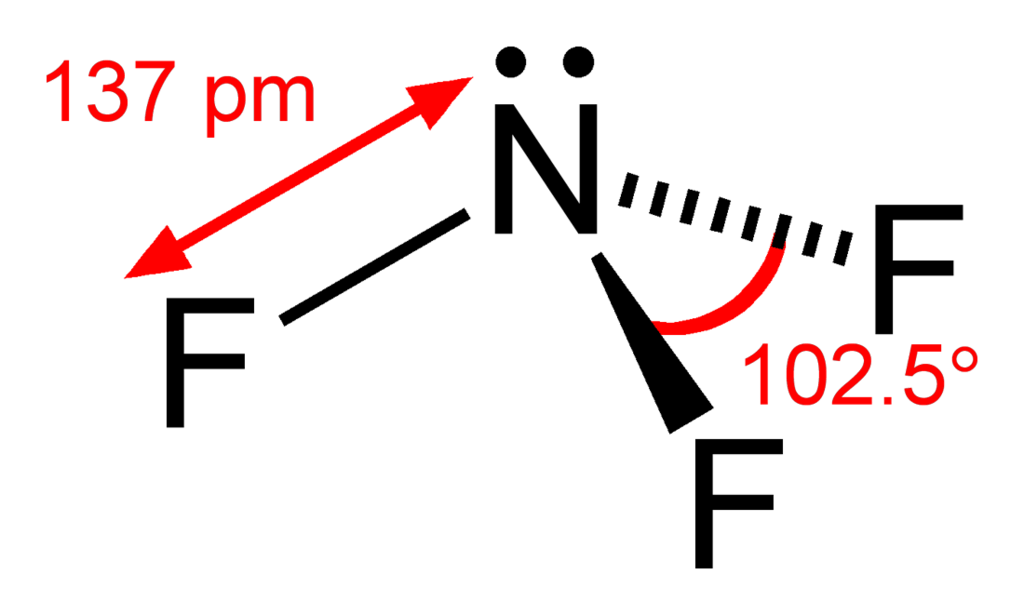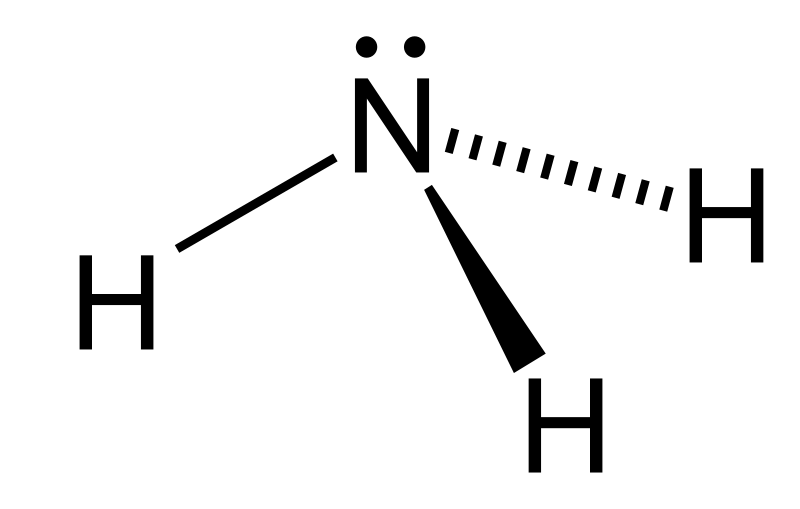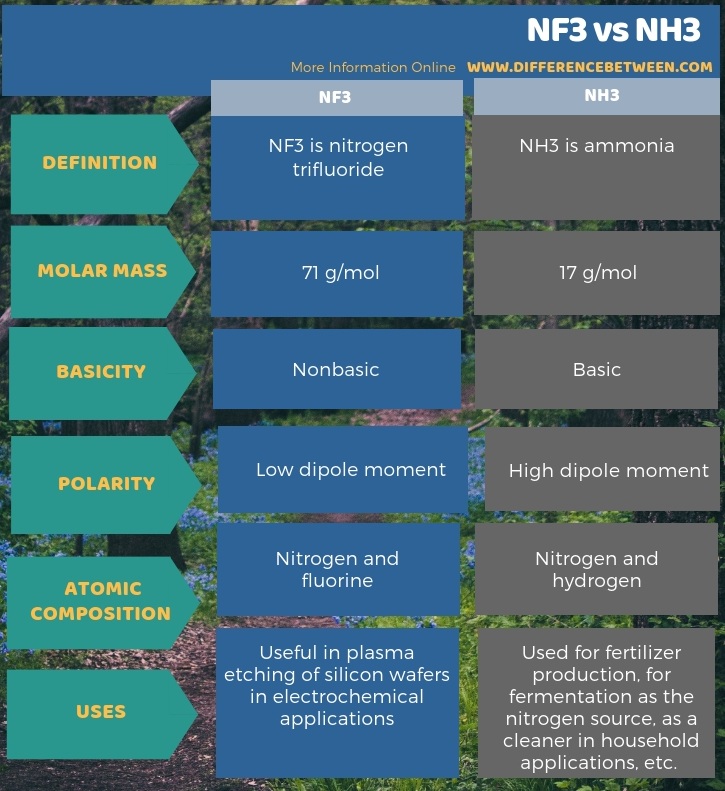Difference Between NF3 and NH3
The key difference between NF3 and NH3 is that NF3 contains three fluorine atoms bound to a central nitrogen atom, while NH3 contains three hydrogen atoms bound to a central nitrogen atom.
NF3 is nitrogen trifluoride while NH3 is ammonia. Both are inorganic compounds, and both compounds have the same molecular geometry. However, they have different chemical and physical properties due to different atomic compositions.
CONTENTS
1. Overview and Key Difference
2. What is NF3
3. What is NH3
4. Similarities Between NF3 and NH3
5. Side by Side Comparison – NF3 vs NH3 in Tabular Form
6. Summary
What is NF3?
NF3 is nitrogen trifluoride. Its common name is trifluoramine. It has three fluorine atoms bound to the same nitrogen atom via covalent chemical bonding. Since nitrogen has five valence electrons and the three fluorine atoms use only three of these electrons to make chemical bonds, there is a lone electron pair on the nitrogen atom. The electron pair and three covalent bonds make the NF3 molecule to have a trigonal pyramidal geometry. The structure is as follows:

Figure 01: Structure of Nitrogen Trifluoride
The molar mass of nitrogen trifluoride is 71 g/mol. It appears as a colourless gas, and it has a mouldy odour. Furthermore, it is a non-flammable gas. However, this gas is a strong greenhouse gas. At the presence of electric discharges, we can prepare this compound using its chemical elements; thus, it is a rare compound we can prepare directly using its chemical elements (nitrogen and fluorine atoms).
Besides, this compound shows significant solubility in water. Furthermore, nitrogen trifluoride is nonbasic, and it has a low dipole moment because the fluorine atoms act as electron-withdrawing groups; thus, they can attract the lone electron pair on the nitrogen atom. Also, this compound is a potent oxidizer as well. When considering the uses of this compound, it is useful in plasma etching of silicon wafers in electrochemical applications.
What is NH3?
NH3 is ammonia. It has three hydrogen atoms bound to the same nitrogen atom. Like nitrogen trifluoride, this compound also has a lone electron pair. It is a binary halide. Furthermore, this compound occurs as a colourless gas, and it has a pungent, irritating odour. The geometry of this compound is trigonal pyramidal.

Figure 02: Structure of Ammonia Molecule
The molar mass of ammonia is 17 g/mol. In nature, we can find this gas as a trace compound formed from nitrogenous waste and nitrogenous animal and plant matter. When considering its uses, about 88% of ammonia is used for fertilizer production. It is also useful as a precursor for nitrogenous compounds. In fermentation processes, ammonia is useful as a nitrogen source for microorganisms. Aqueous ammonia is also important as a cleaner in household applications.
What are the Similarities Between NF3 and NH3?
- NF3 and NH3 are binary compounds.
- They have the same geometry – trigonal pyramidal
- Moreover, both occur as colourless gases
- In addition to these, both molecules have lone electron pairs on nitrogen atoms.
What is the Difference Between NF3 and NH3?
NF3 is nitrogen trifluoride while NH3 is ammonia. The key difference between NF3 and NH3 is that the NF3 contains three fluorine atoms bound to a central nitrogen atom, while the NH3 contains three hydrogen atoms bound to a central nitrogen atom. The molar mass of nitrogen trifluoride is 71 g/mol while the molar mass of ammonia it is 17 g/mol. Moreover, NF3 is nonbasic while NH3 is a basic compound; NF3 has a low dipole moment, but NH3 has a high dipole moment. NF3 is mainly useful in plasma etching of silicon wafers in electrochemical applications. In contrast, NH3 is useful for fertilizer production, for fermentation as the nitrogen source, as a cleaner in household applications, etc.
The below infographic summarizes the difference between NF3 and NH3.

Summary – NF3 vs NH3
NF3 is nitrogen trifluoride while NH3 is ammonia. Both are inorganic compounds. The key difference between NF3 and NH3 is that the NF3 contains three fluorine atoms bound to a central nitrogen atom, while the NH3 contains three hydrogen atoms bound to a central nitrogen atom.
Reference:
1.“Nitrogen Trifluoride.” National Center for Biotechnology Information. PubChem Compound Database, U.S. National Library of Medicine, Available here.
2. “Ammonia.” National Center for Biotechnology Information. PubChem Compound Database, U.S. National Library of Medicine, Available here.
3. “Nitrogen Trifluoride.” Wikipedia, Wikimedia Foundation, 23 Sept. 2019, Available here.
Image Courtesy:
1. “Nitrogen-trifluoride-2D-dimensions” By Benjah-bmm27 – Own work (Public Domain) via Commons Wikimedia
2. “Ammonia-2D” By Radio89 – Own work (CC BY-SA 3.0) via Commons Wikimedia
ncG1vNJzZmivp6x7pbXFn5yrnZ6YsqOx07CcnqZemLyue8OinZ%2Bdopq7pLGMm5ytr5Wau266xWxkmqaUYrupf44%3D